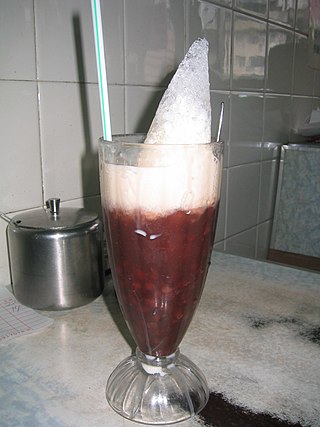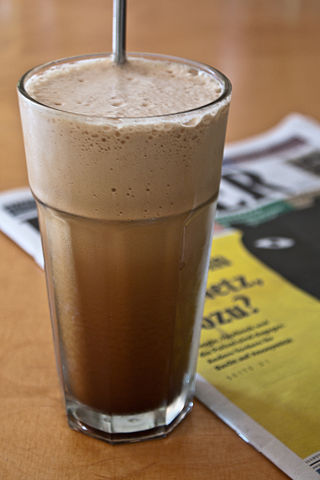
Bubble tea is a tea-based drink that originated in Taiwan in the early 1980s. Taiwanese immigrants brought it to the United States in the 1990s, initially in California through regions including Los Angeles County, but the drink has also spread to other countries where there is a large East Asian diaspora population.

Frappuccino is a line of blended iced coffee drinks sold by Starbucks. It may consist of coffee or crème base, blended with ice and ingredients such as flavored syrups and usually topped with whipped cream and or spices. It may also include blended Starbucks refreshers. Frappuccinos are also sold as bottled coffee beverages in grocery stores, convenience stores and from vending machines.

A coffeehouse, coffee shop, or café, is an establishment that serves various types of coffee, espresso, latte, americano and cappuccino. Some coffeehouses may serve iced coffee among other cold beverages, such as iced tea, as well as other non-caffeinated beverages. A coffeehouse may also serve food, such as light snacks, sandwiches, muffins, cakes, breads, donuts or pastries. In continental Europe, some cafés also serve alcoholic beverages. Coffeehouses range from owner-operated small businesses to large multinational corporations. Some coffeehouse chains operate on a franchise business model, with numerous branches across various countries around the world.

Cha chaan teng, often called a Hong Kong-style cafe or diner in English, is a type of restaurant that originated in Hong Kong. Cha chaan tengs are commonly found in Hong Kong, Macau, and parts of Guangdong. Due to the waves of mass migrations from Hong Kong in the 1980s, they are now established in major Chinese communities in Western countries such as Australia, Canada, the United Kingdom, and the United States. Likened to a greasy spoon cafe or an American diner, cha chaan tengs are known for eclectic and affordable menus, which include dishes from Hong Kong cuisine and Hong Kong-style Western cuisine. They draw comparisons to Western cafés due to their casual settings, as well as menus revolving around coffee and tea.

Hong Kong cuisine is mainly influenced by Cantonese cuisine, European cuisines and non-Cantonese Chinese cuisines, as well as Japanese, Korean and Southeast Asian cuisines, due to Hong Kong's past as a British colony and a long history of being an international port of commerce. Complex combinations and international gourmet expertise have given Hong Kong the labels of "Gourmet Paradise" and "World's Fair of Food".

Hong Kong–style milk tea, also known as "silk-stocking" milk tea (絲襪奶茶), is a tea drink made from Ceylon black tea and evaporated milk. The drink originated in the mid-20th century during the British rule of Hong Kong, and was inspired by the British's afternoon tea.

The egg tart is a kind of custard tart found in Chinese cuisine, derived from the English custard tart and Portuguese pastel de nata. The dish consists of an outer pastry crust filled with egg custard. Egg tarts are often served at dim sum restaurants, Chinese bakeries and cha chaan tengs.

A kopitiam or kopi tiam is a type of coffee shop mostly found in parts of Indonesia, Malaysia, Singapore, Brunei and Southern Thailand patronised for meals and beverages, and traditionally operated by the Chinese communities of these countries. The word kopi is an Indonesian and Malay term for coffee and tiam is the Hokkien/Hakka term for shop. Traditional kopitiam menus typically feature simple offerings: a variety of foods based on egg, toast, kaya, plus coffee, tea, Horlicks and Milo. Modern kopitiams typically feature multiple food stalls that offer a wider range of foods.

Dai pai dong is a type of open-air food stall. The term originates from Hong Kong but has been adopted outside Hong Kong as well. The official government name for these establishments is "cooked-food stalls". The more common name of dai pai dong literally means 'big licence stall' in Cantonese, referring to the stalls' license plates, which are larger than those of other licensed street vendors.

Red bean ice is a drink commonly found in Hong Kong. It is usually served in restaurants like cha chaan teng. It is a popular dessert in the summer. The standard ingredients include adzuki beans, light rock sugar syrup, and evaporated milk. It is often topped with ice cream to become a dessert known as red bean ice cream.

A frappé coffee, cold coffee, Greek frappé, or just frappé is a Greek iced coffee drink generally made from spray-dried instant coffee, water, sugar, and milk. The word is often written frappe. The frappé was invented in 1957 in Thessaloniki through experimentation by Dimitris Vakondios, a Nescafe representative. Greek Christos Lenzos (1930-2023), a coffeehouse (1964-2013) owner in Pangrati, has been recognized for his self-made version of Greek frappé coffee. Frappés are among the most popular forms of coffee in Greece and Cyprus and have become a hallmark of postwar outdoor Greek coffee culture.

Kopi, also known as Nanyang coffee, is a traditional coffee beverage found in several Southeast Asian nations. Often brewed to be highly caffeinated, it is commonly served with sugar and/or milk-based condiments. The drink originated during the British Malaya era and has Hainanese cultural roots. Its name is derived from the Malay term for coffee. The term Nanyang, which means "south sea" in Mandarin, refers to Southeast Asia. Kopi-culture vocabulary is grounded in the Hokkien language as a result of historical immigration to Southeast Asia from the Minnan region of Fujian Province, in southeastern China. The beverage is usually served in coffee shops, hawker centres, and kopitiams across the region.

Tsui Wah Restaurant is a chain of tea restaurants owned by Tsui Wah Holdings Limited, headquartered in Hong Kong. The restaurants serve Hong Kong-style food.

Bing sutt is a type of traditional cold drinking house started in Guangzhou (Canton) that spread to Hong Kong. These bing sutts arose in the 1950s and 1960s. They are characterized by old furniture and settings such as the small tiled floors, hanging fans, folding chairs and so on. A bing sutt provides light meals and drinks and is neighbourhood-oriented. It is believed to be the predecessor of the cha chaan teng.

Australia Dairy Company (澳洲牛奶公司) is a traditional Hong Kong restaurant, cha chaan teng, in Jordan, Hong Kong, specialising in steamed milk pudding, scrambled eggs, toast and custard dishes. The company was named by the founder, who had worked on an Australian farm in the 1940s.

Hidden Faces is a 2015 Hong Kong medical drama series produced by Hong Kong Television Network. The first episode premiered on 24 July 2015.

Ngan Lung Catering (Holdings) Limited is a cha chaan teng restaurant chain founded by Lau Choi Lung in 1963 in Hong Kong. The chain currently has 18 locations, primarily serving Kowloon and the New Territories. It also operates three restaurants on Hong Kong Island. Food items offered at each outlet varies, although most of the available food choices are standard, and are reminiscent of Hong Kong traditional cha chaan teng and bing sutt food culture.

















